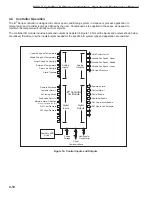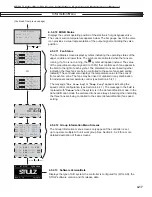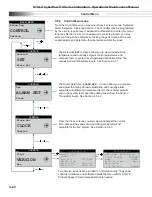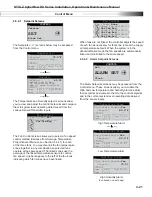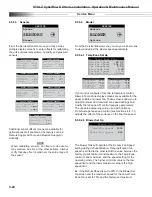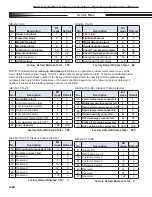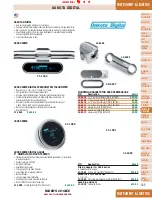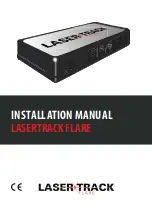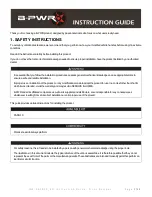
STULZ CyberRow DX Series Installation, Operation & Maintenance Manual
Alarm
Log
Menu
4-18
4.5.3 Alarm
Log
MAIN MENU
Info
ALARM LOG
Control
No password is required to view alarm display messages.
If an alarm condition occurs, the fi rst active alarm may
be displayed by pressing the Alarm ( ) key. The alarm
screen display text message will remain unchanged until
the alarm condition is cleared.
If the alarms log is entered from the main menu, any
other active alarm message(s) may be viewed by using
the Up ( ) and Down
( ) arrow keys to scroll through
alarm messages.
4.5.3.1 Alarms
The red LED backlight within the alarm key will illuminate
any time an alarm condition is present or previous
alarms existed without having been reset or cleared. An
audible alarm will also activate when an alarm condition
occurs. The audible alarm may be enabled or disabled
in the Service>Options menu loop. The fi rst active
alarm screen may be displayed by pressing the Alarm
( ) key. The Alarm display provides you with a text
message describing the abnormal operating condition.
Use of the Up ( ) and Down
( ) arrow keys allows you
to scroll for any additional alarm messages. Only active
alarm screens will be displayed when the Alarm ( ) key is
pressed. The alarm screen display will remain unchanged
until the alarm condition is corrected and the alarm key is
pressed again to clear the alarm.
When access is gained to the Alarm Log loop, use of
the Up ( ) and Down
( ) arrow keys allows you to scroll
through the log for a history of alarm messages. The
alarms log may be cleared in the Service>Alarm log
menu loop.
The application software supports two (2) types of
alarms,
“Non-Critical
” and “
Critical
”. Any alarm may be
programmed to activate the “Custom” (user confi gured)
alarm relay contacts.
4.5.3.2 Non-Critical
Alarms
A
Non-Critical
alarm will activate the alarm screen with
which it is associated. These alarms are programmed to
activate the “Summary Fault” alarm and close the “Sum-
mary Fault" relay contacts without stopping unit opera-
tion. Some examples of the factory programmed,
Non-
Critical
alarms are:
•
High Temperature
•
Moisture Detection
•
Low Temperature
•
Change Filter
•
High Humidity
•
Sensor Failure
•
Low Humidity
•
Communication Failure
4.5.3.3 Critical Alarms
Critical
Alarms will coincide with automatic shut down
of the A/C unit(s) equipment as needed to prevent
possible system damage. The A/C unit(s) equipment
will remain shut down until the alarm condition(s) are no
longer sensed and the controller has been reset. Some
examples of
Critical
alarms are:
•
No Air Flow
•
High Head Pressure
(Air Proving Switch)
•
Low Suction Pressure
•
Fire/Smoke Detection
•
Off by Internal Alarm
(Only for grouped systems)
Summary of Contents for CyberRow DX CRS-042-G
Page 94: ......







